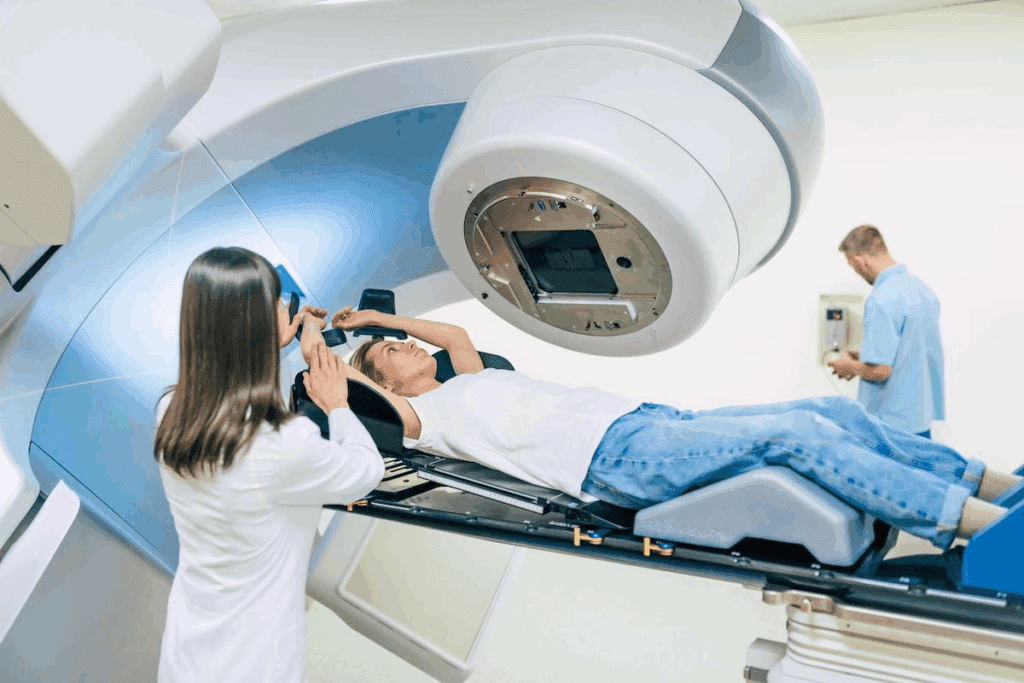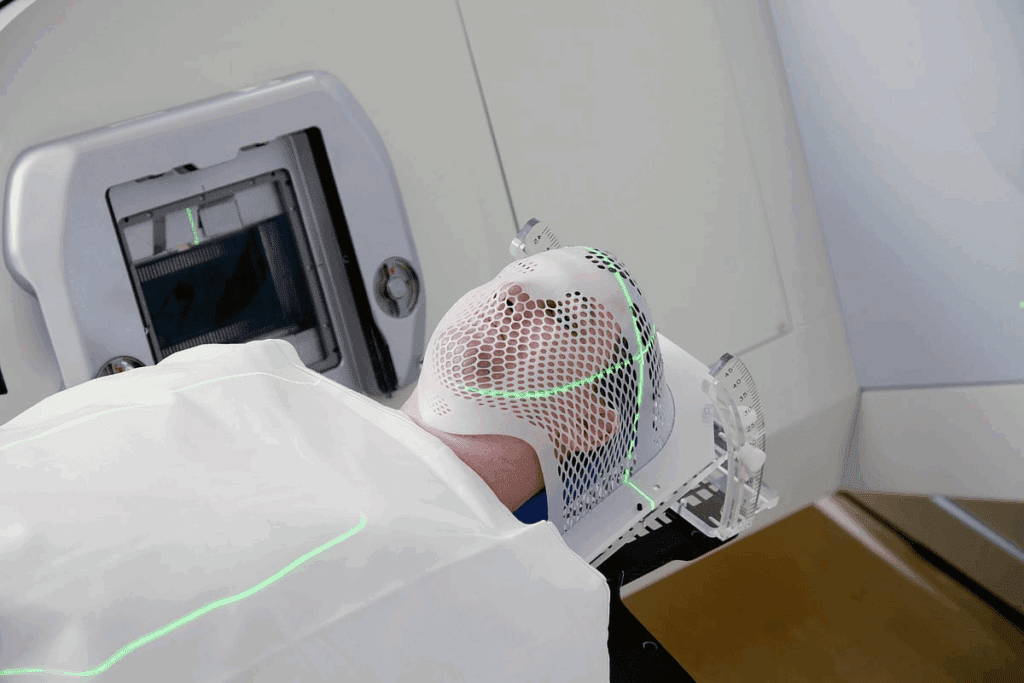Last Updated on November 26, 2025 by Bilal Hasdemir

At Liv Hospital, we know how important it is to pick the right imaging method. This is true, more so for those worried about radiation. MRI and ultrasound are safer choices for many, like kids and pregnant women. Which of these imaging methods does not use any radiation? We give the surprising answer and explore radiation-free options like MRI.
MRI uses strong magnets and radio waves to make detailed images without radiation. This tech, paired with artificial intelligence in medical imaging diagnosis, makes diagnoses more accurate and quicker. We’re dedicated to giving you the best care, focusing on your health and safety.
Key Takeaways
- MRI and ultrasound are safer imaging alternatives that do not use radiation.
- Artificial intelligence enhances the accuracy and speed of medical imaging diagnosis.
- Liv Hospital offers advanced, patient-centered radiation-free diagnostic options.
- These imaging methods are beneficial for vulnerable patient groups.
- Our diagnostic options prioritize patient health and safety.
Understanding Medical Imaging Technologies

Medical imaging has changed a lot over the years. This change is thanks to new technology and a focus on keeping patients safe. It’s important to know about the different imaging methods and what they offer.
The Evolution of Diagnostic Imaging
Diagnostic imaging has come a long way. From the first X-rays to today’s MRI and Ultrasound, it’s all about getting better. These new tools help doctors make accurate diagnoses faster, which is great for patients.
There’s a big push for safer imaging because of radiation concerns. X-rays and CT scans use radiation, but MRI and Ultrasound don’t. This helps doctors choose the right imaging for each patient, keeping safety in mind.
The Importance of Radiation Awareness in Healthcare
Knowing about radiation in healthcare is key, mainly with imaging. It’s important to understand the difference between imaging that uses radiation and that which doesn’t. This helps doctors make better choices for their patients.
The table below shows how different imaging methods use radiation and their ability to diagnose:
| Imaging Modality | Use of Ionizing Radiation | Diagnostic Capability |
| X-ray | Yes | High |
| CT Scan | Yes | Very High |
| MRI | No | Very High |
| Ultrasound | No | High |
Healthcare providers can pick the best imaging for each patient by knowing these differences. This ensures both accurate diagnosis and safety. As we keep improving, using less radiation will be key to better patient care.
Radiation vs. Radiation-Free Imaging: What’s the Difference?

Medical imaging has grown to include both radiation-based and radiation-free options. Each has its own benefits and things to think about. At Liv Hospital, we follow international care standards. We make sure our patients get the safest and most fitting diagnostic imaging.
How Ionizing Radiation Works in Medical Imaging
Ionizing radiation, like in X-rays and CT scans, goes through body tissues differently. This lets us see inside the body. But, we must weigh the good it does against the risks of radiation.
Key aspects of ionizing radiation in medical imaging include:
- Differential absorption of radiation by various tissues
- Image creation based on radiation that passes through the body
- Potential risks associated with radiation exposure
The Science Behind Radiation-Free Alternatives
Options like MRI and ultrasound don’t use ionizing radiation. MRI uses strong magnetic fields and radio waves for detailed images of soft tissues. This is great for looking at the brain, spine, and joints.
Notable benefits of radiation-free imaging include:
- Reduced risk of radiation-induced harm
- Enhanced safety for patients needing repeated scans
- More information to go with radiation-based imaging
| Imaging Modality | Radiation Use | Primary Diagnostic Use |
| X-ray | Yes | Bone fractures, lung conditions |
| MRI | No | Soft tissue abnormalities, neurological conditions |
| Ultrasound | No | Obstetric conditions, abdominal organ assessment |
Patient Safety Considerations
At Liv Hospital, we put patient safety first. We think about the patient’s health history, what we’re trying to find out, and radiation risks. This careful planning makes sure our patients get the best care with the least risk.
Patient safety considerations include:
- Deciding if radiation-based imaging is needed
- Choosing radiation-free options when they’re good enough
- Making sure patients understand their imaging choices
Which of These Imaging Methods Does Not Use Any Radiation?
Looking for ways to avoid radiation in imaging, we’ve found three key methods. These are Magnetic Resonance Imaging (MRI), Ultrasound Technology, and Magnetic Particle Imaging (MPI). They don’t use radiation.
Magnetic Resonance Imaging (MRI)
MRI uses strong magnets and radio waves to show body details. It’s great for soft tissue issues like tumors and injuries. AI tools have made MRI images clearer and more accurate.
AI can spot problems faster, helping doctors diagnose quicker. This leads to better care for patients.
| Advantages of MRI | Applications |
| No radiation exposure | Soft tissue imaging |
| High-resolution images | Tumor detection |
| Multi-planar imaging | Vascular disease diagnosis |
Ultrasound Technology
Ultrasound uses sound waves for real-time images of organs and blood flow. It’s safe and non-invasive, used for many conditions. It’s also great for guiding procedures.
A medical expert says, “Ultrasound has changed diagnostic medicine. It’s safe and effective without radiation.” Protecting patient data is key, with cyber security measures in place.
Magnetic Particle Imaging (MPI)
MPI uses magnetic particles for body imaging. It’s promising for vascular imaging and could offer detailed images without radiation.
MPI is new but shows great promise. Like MRI, AI tools could make MPI even better.
“The future of medical imaging is about safety and accuracy. MPI is a promising technology.”
In summary, MRI, Ultrasound, and MPI are big steps in radiation-free imaging. With AI tools and better cyber security measures, these methods will get even safer and more effective.
Magnetic Resonance Imaging (MRI): The Power of Magnets
Magnetic Resonance Imaging (MRI) is a key tool for safe imaging. It uses strong magnets and radio waves. This method creates detailed images of soft tissues inside the body without harmful radiation.
How MRI Technology Works
MRI machines create a strong magnetic field. This field aligns hydrogen atoms in the body. Then, radio waves disturb these atoms, sending signals to the MRI machine.
These signals help make detailed images of the body’s inside. The process involves several important parts:
- A strong magnetic field to align hydrogen atoms
- Radio waves to disturb the aligned atoms
- A receiver coil to detect the signals emitted
- Advanced computer algorithms to reconstruct images
Types of MRI Scans and Their Applications
There are many MRI scans, each for different uses:
- Functional MRI (fMRI): It checks brain activity by looking at blood flow changes.
- Magnetic Resonance Angiography (MRA): It shows blood vessels and helps find vascular problems.
- Magnetic Resonance Spectroscopy (MRS): It tells us about tissue metabolism.
These MRI types help doctors diagnose and track many health issues. This includes brain and heart problems.
Benefits and Limitations of MRI
MRI offers clear images of soft tissues without harmful radiation. This makes it a great tool for many health checks. But, MRI has some downsides too.
It can be expensive and not always available. Also, some people with metal implants or pacemakers can’t have an MRI. Despite these challenges, MRI is a top choice for medical imaging. It offers diagnostic capabilities and excellence in imaging. We keep improving MRI to help more patients around the world.
Ultrasound Imaging: Sound Waves in Medicine
Sound waves are used in ultrasound imaging to give doctors important information. This method is safe and works well for diagnosing diseases.
The Science Behind the Technology
Ultrasound imaging sends high-frequency sound waves into the body. These waves bounce off inside structures and are caught by a probe called a transducer. The transducer then turns these waves into electrical signals.
These signals are processed to show real-time images of the body’s inside. Innovation in ultrasound has made it better for diagnosing. Today’s machines have advanced software that makes images clearer and gives more detailed info.
Different Types of Ultrasound Procedures
There are many ultrasound procedures, each for different needs. Some common ones are:
- Abdominal ultrasound: Looks at organs like the liver, gallbladder, and kidneys.
- Obstetric ultrasound: Used during pregnancy to check on the baby.
- Vascular ultrasound: Checks blood flow and finds vascular diseases.
Each ultrasound is made to give detailed views of certain body parts. This helps doctors make accurate diagnoses and plans for treatment.
Real-Time Visualization Benefits
Ultrasound imaging is great because it shows things in real-time. This is very helpful for guiding procedures and watching how the body works.
We focus on the patient with ultrasound technology. It’s safe and effective, and it’s good for people who can’t handle other tests, like pregnant women and kids. It doesn’t use harmful radiation.
| Type of Ultrasound | Primary Use | Benefits |
| Abdominal | Examine liver, gallbladder, kidneys | Non-invasive, real-time imaging |
| Obstetric | Monitor fetal development | Safe for pregnant women, detailed fetal imaging |
| Vascular | Assess blood flow, detect vascular diseases | Real-time blood flow assessment, guides interventions |
Emerging Technology: Magnetic Particle Imaging (MPI)
MPI, or Magnetic Particle Imaging, is a new way to see inside the body without radiation. It’s changing how we do medical imaging by giving us clear pictures without harmful radiation.
How MPI Works and Its Unique Features
Magnetic Particle Imaging uses tiny magnetic particles to make detailed images. It involves injecting a special tracer into the blood, which the MPI scanner can detect. This tech is very sensitive and specific, showing blood flow and organ function in real-time.
What makes MPI special is its ability to measure the concentration of these particles. It also doesn’t have the depth limits of other imaging methods. This makes it great for seeing deep inside the body.
Portability and Clinical Applications
One big plus of MPI is its portability. It can be taken to the patient, not the other way around. This is super helpful in emergency situations or for patients who can’t move.
Doctors are looking at MPI for many uses, like heart imaging and cancer treatment. It’s perfect for guiding small procedures and checking how treatments are working.
Future of MPI in Interventional Procedures
The future of MPI is bright, with big hopes for interventional procedures. Its real-time images can make these procedures safer and more precise. As MPI gets better, it will likely be used more in hospitals, helping patients get better faster.
As MPI research keeps going, it will become a key tool in medical imaging. It’s a safe and effective way to see inside the body without radiation.
Radiation-Based Imaging Methods: When They’re Necessary
Radiation-free imaging is preferred, but sometimes, radiation-based methods are needed. They are accurate and key for diagnosing many health issues.
X-Ray Technology and Applications
X-rays are a common imaging method. They use X-ray radiation to create images of the body’s inside. This helps doctors see bones, find fractures, and check for osteoporosis.
“X-rays have been a cornerstone of medical imaging for over a century, providing a quick and effective means of diagnosing a variety of conditions,” says a leading radiologist. Digital X-ray systems have improved image quality and lowered radiation doses.
Computed Tomography (CT) Scans
CT scans use X-rays to create detailed images of the body’s inside. They are great for finding tumors, vascular diseases, and internal injuries.
CT scans are known for their accuracy. They help doctors see the body’s inside clearly. This is very useful in emergency medicine and oncology.
Positron Emission Tomography (PET) Scans
PET scans use radioactive tracers to see how the body works. They are mainly used in oncology to find cancer, see how it spreads, and check treatment success.
PET scans give functional information about the body’s tissues. This helps when combined with CT and MRI scans. PET-CT scans are very useful for making accurate diagnoses and planning treatments.
Specialty Departments: Radiology and Nuclear Medicine
Radiation-based imaging is mainly used in radiology and nuclear medicine. Radiology focuses on X-rays, CT scans, and more. Nuclear medicine deals with radioactive tracers, like in PET scans.
Both departments are vital in patient care. They work with other specialties to use imaging wisely. Radiologists and nuclear medicine specialists are key in interpreting images and making treatment plans.
How Healthcare Providers Determine the Appropriate Imaging Method
Choosing the right imaging method is complex. It depends on what’s needed for diagnosis and how much radiation is involved. Healthcare providers aim to find the best imaging for each patient’s condition.
Clinical Decision-Making Process
Choosing an imaging method starts with a detailed look at the patient’s history and symptoms. Healthcare providers look at the type of injury, how severe it is, and the patient’s overall health. This helps them pick the best imaging, like MRI, ultrasound, or others.
For example, MRI is often used for musculoskeletal injuries because it shows soft tissues well. Ultrasound is good for vascular checks and guiding procedures because it’s safe and shows things in real-time.
Balancing Diagnostic Needs with Radiation Concerns
It’s important to weigh the need for diagnosis against the risk of radiation. Healthcare providers try to use less radiation, like MRI and ultrasound, for those at risk, like kids and pregnant women.
In kids, ultrasound is often first because it’s safe and works well for certain conditions. For pregnant women, MRI is used for detailed images without radiation.
Special Considerations for Vulnerable Populations
Special care is needed for vulnerable groups, like kids, pregnant women, and those with certain health issues. Healthcare providers must think about the unique needs and risks of these groups to keep them safe and comfortable.
In kids, MRI and ultrasound are key because they don’t use radiation. For pregnant women, the choice of imaging must balance benefits and risks for both mom and baby.
By picking the right imaging method, healthcare providers can give patients the best care. This approach makes care safer and more efficient. It helps improve healthcare security for everyone.
Artificial Intelligence in Medical Imaging: Redefining Diagnostic Standards
Artificial intelligence is changing how we diagnose with medical imaging. At Liv Hospital, we lead in using AI with safe imaging. This boosts our ability to diagnose while keeping patients safe.
Integration with Radiation-Free Technologies
AI and safe imaging like MRI and ultrasound are changing medicine. AI algorithms can handle complex data better and faster than old methods. This helps doctors make better choices.
For example, AI-enhanced MRI scans show internal details without harmful radiation. This makes diagnoses more accurate and safer for patients.
Enhanced Accuracy and Speed in Diagnosis
AI tools make medical diagnoses quicker and more accurate. AI looks through lots of data to find patterns and problems humans might miss.
This is very helpful in emergencies where quick and right diagnosis is key. With AI, we can diagnose faster and more accurately, leading to better care for patients.
Cybersecurity Measures in Medical Imaging
As medical imaging uses more AI and digital tech, keeping data safe is very important. At Liv Hospital, we take strong steps to protect patient data and keep our systems safe.
- Advanced encryption methods to secure data transmission
- Regular software updates to patch vulnerabilities
- Strict access controls to prevent unauthorized access
Liv Hospital’s Approach to AI-Enhanced Imaging
Liv Hospital uses the newest AI to improve our imaging. Our focus is on innovative, patient-focused care. We aim for accurate diagnoses and patient safety.
By using AI with our imaging, we offer top-notch diagnostic services. These services meet the highest standards of quality and care.
Conclusion: The Future of Safe Medical Imaging
Medical imaging is getting better, thanks to MRI and ultrasound. These methods are key to keeping patients safe from radiation. They help doctors give top-notch care without harming patients with too much radiation.
At Liv Hospital, we focus on making medical imaging safe and accurate. We use the latest tech to ensure our patients get the best care. This is our promise to you.
It’s important for healthcare workers to know about radiation safety. MRI and ultrasound are essential for safe imaging. They will play a bigger role in the future.
We aim to make medical imaging safer and more accurate. Our goal is to provide quality care and keep patients safe. We’re excited for what the future holds in this field.
FAQ
References
What are the benefits of radiation-free imaging methods?
Radiation-free imaging, like MRI and ultrasound, is safer for patients. It’s great for kids and pregnant women. These methods give accurate diagnoses without the dangers of radiation.
How does MRI technology work?
MRI uses strong magnetic fields and radio waves to show body details. It’s best for soft tissues. Doctors use it to check the brain, spine, and joints.
What is the role of artificial intelligence in medical imaging diagnosis?
Artificial intelligence helps make medical imaging faster and more accurate. AI quickly checks images for problems. At Liv Hospital, AI is safe and protects patient data.
Are there any emerging radiation-free imaging technologies?
Yes, magnetic particle imaging (MPI) is new and doesn’t use radiation. It’s portable and very sensitive. MPI could make procedures better and help diagnose more accurately.
How do healthcare providers choose the appropriate imaging method for a patient?
Doctors look at the patient’s health, what they need to diagnose, and radiation risks. For those at risk, like kids and pregnant women, they choose safer options. They weigh the need for a good diagnosis against the risks of each method.
What are the advantages of ultrasound imaging?
Ultrasound is safe and shows things in real-time. It’s non-invasive and doesn’t use harmful radiation. It’s used for many things, like checking babies and looking at the abdomen and blood vessels.
How does Liv Hospital approach AI-enhanced imaging?
Liv Hospital uses AI with strong security to improve diagnosis. We focus on innovation and putting patients first. Our goal is to give top-notch healthcare.
What is the difference between radiation-based and radiation-free imaging?
Radiation-based imaging, like X-rays and CT scans, uses harmful radiation. Radiation-free methods, like MRI and ultrasound, don’t. The choice depends on what’s needed and patient safety.
Reference
- American Cancer Society – Signs & Symptoms of Teen Cancer
https://www.cancer.org/cancer/types/cancer-in-adolescents/finding-cancer-in-adolescents.html






